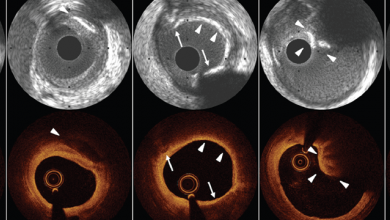Search results
Author(s):
Yasar Sattar
,
Prasanna M Sengodan
,
Mustafa Sajjad Cheema
,
et al
Added:
10 months ago
Author(s):
Katrina Mountfort
Added:
3 years ago
Proceedings of two satellite symposia held at EuroPCR, Paris in May 2015
Although the latest polymeric drug-eluting stents (DES) have enhanced percutaneous coronary intervention (PCI) procedures, a substantial proportion of patients requiring percutaneous transluminal coronary angiography (PTCA) is elderly with numerous different comorbidities. This population requires use of effective DES that…
View more
Author(s):
Yasushi Ueki
,
Tatsuhiko Otsuka
,
Kiyoshi Hibi
,
et al
Added:
3 years ago
Heavily calcified coronary artery lesions hinder device delivery and limit stent expansion, which is the most relevant predictor of stent failure. This may result in low procedural success and poor clinical outcomes. Coronary angiography has a limited ability to detect calcifications when planning an optimal percutaneous coronary intervention (PCI) strategy. Intracoronary imaging can provide…
View more
Author(s):
Sean Fitzgerald
,
Maria Rubini Gimenez
,
Abdelhakim Allali
,
et al
Added:
1 year ago
Author(s):
Salvatore Brugaletta
,
Hector M Garcia-Garcia
,
Patrick W Serruys
Added:
3 years ago
The identification of vulnerable plaques has been a longstanding challenge for interventional cardiologists. Plaque composition is regarded as an important feature for assessment of plaque vulnerability. Histopathologists have in particular shown that the type of plaque most commonly prone to rupture in vivo is the thin-cap fibroatheroma (TCFA), in which the presence of lipid core (also called…
View more
Author(s):
Alfredo Galassi
,
Aaron Grantham
,
David Kandzari
,
et al
Added:
3 years ago
Section A
Techniques for Chronic Total Occlusions Revascularisation
Access Route, Guiding Catheter Selection and Contralateral Injection
The femoral approach is the preferred access route by most operators. However, the radial approach might be chosen because of severe peripheral vascular disease, operator’s preference or for contralateral injection. The guiding principle of access selection is…
View more
Author(s):
David Smith
,
Ahmed Hailan
,
Alexander Chase
Added:
3 years ago
Radial vs Femoral Access
In recent years several large registries and randomised controlled trials have demonstrated a mortality benefit for trans-radial over trans-femoral percutaneous coronary intervention (PCI), likely mediated by reduced bleeding complications.1–4 Building on the pioneering Japanese experience, the advent of the hybrid algorithim approach, coupled with innovative new…
View more
Clinical Impact of Stent Design
Author(s):
Rebecca L Noad
,
Colm Hanratty
,
Simon J Walsh
Added:
3 years ago
Article
Author(s):
Kalaivani Mahadevan
,
Claudia Cosgrove
,
Julian Strange
Added:
2 years ago
Author(s):
Jun Hua Chong
,
Arjun K Ghosh
Added:
3 years ago
Cardiovascular disease is the leading cause of morbidity and mortality worldwide.1 The WHO estimates that 17 million people die each year of cardiovascular disease, about 30% of all deaths.2 Cancer is the second leading cause of death globally and is associated with 9 million deaths each year.3 According to the WHO, the incidence of cancer is expected to rise by about 70% over the next 20 years.4…
View more














